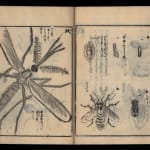 Volume 3, insects seen through a microscope. On the left a mosquito, on the right shows the development of a fly from egg, through larvae and pupae stages.
Volume 3, insects seen through a microscope. On the left a mosquito, on the right shows the development of a fly from egg, through larvae and pupae stages.
 Volume 3, an illustration of a microscope (ミコラスコーピユン之図)
Volume 3, an illustration of a microscope (ミコラスコーピユン之図)
 Volume 1, a lizard in a jar (titled as a draak [dragon]), a gift to Katsuragawa Hoshu by Carl Peter Thunberg.
Volume 1, a lizard in a jar (titled as a draak [dragon]), a gift to Katsuragawa Hoshu by Carl Peter Thunberg.
 Volume 4, first page of appendix illustrating the clothes of a "red hair", or Dutchman.
Volume 4, first page of appendix illustrating the clothes of a "red hair", or Dutchman.
Shiba Kokan (1747-1818) (artist) Kitao Masayoshi (1764-1824) (artist) Morishima Churyo (1754-1810) (author and editor)
Dated: Tenmei 7 (1787)
Various publishers, no colophon
Binding: fukurotoji (pouch binding), pale blue covers embossed imitating Dutch leather
Further images
The author of Komo Zatsuwa, Morishima Churyo (1754-1810) was the younger brother of Katsuragawa Hoshu (1751-1809), a physician who served the Shogunate. Hosho made active efforts to gain new Western knowledge, such as by talking with Carl Peter Thunberg (1743-1828) and others in the retinue of the chief of the Dutch VOC factory when in Edo visiting the court. Knowledge obtained during these discussions was recorded by Morishima Churyo in Komo Zatsuwa. He also added sections based on topics he had read in Dutch books. Illustrations were provided by artists including Shiba Kokan (1747-1818) and Kitao Masayoshi (1764-1824).
The illustrations by Shiba Kokan of things seen through a microscope are especially well-known and include rice and poppy seeds as well as insects including a mosquito, larvae and even a psocid; the pest responsible for eating through woodblock prints and books.
400 years of exchange between Japan and Holland began in 1600 when a Dutch ship, the de Liefde, ran aground on the coast of Usuki in Bungo Province (present-day Usuki City, Oita Prefecture). A few years later, in 1609 a ship of the Dutch East India Company (Vereenigde Oost-Indische Compagnie or VOC) docked at Hirado in Kyushu, leading to the formal granting of permission of trading rights for the Dutch with Japan by Tokugawa Ieyasu (1542-1616). In 1641, due to concerns regarding the spread of Christianity, the Portuguese were expelled from Japan and the Dutch were moved to the island of Deshima off Nagasaki where interactions between Japanese and Dutch traders were permitted but strictly regulated.
Initial exchanges between the Dutch and Japanese were limited to trade, however it gradually expanded to include that of knowledge. Over time the study of Western knowledge increased in momentum, especially during the reign of the 8th shogun Tokugawa Yoshimune (1684–1751) who actively promoted the study of Rangaku (lit. 'Dutch Learning). Yoshimune relaxed a ban on the import of foreign non-Christian-related books and many Dutch scientific books were acquired and translated by Rangaku scholars. Such studies focused mainly on subjects such as medicine, astronomy, natural history, botany, and chemistry. In addition to books, the acquisition was possible of Western curiosities and manufactures such as clocks, medical instruments, celestial and terrestrial globes and maps.
The inside front cover of each volume of this set of Komo Zatsuwa bears the stamp “Library (藏書) of Aston (阿須頓) from Britain (英國)”, indicating William George Aston (1841-1911), a British consular official in Japan and Korea. He made a major contribution to the studies of Japan's language and history during the nineteenth century. Along with Ernest Mason Satow (1843-1929) and Basil Hall Chamberlain (1850-1935), Aston was one of three major British Japanologists active in Japan at the time. He was the first translator of the Nihongi into English. In 1912 Cambridge University Library acquired 9,500 Japanese books from Aston's collection which formed the starting point of the Library's collection.(1)
Komo Zatsuwa contents:
Volume 1 begins with the history and customs of the Netherlands and goes on to describe hospitals and airships.
Volume 2 covers Turkish castle towns, the Ling Jiou Mountain in Taiwan, and the geographic situation of Java, Indonesia.
Volume 3 gives an account of the sea route from Amsterdam to Japan, passing France, Spain and the Cape of Good Hope, depicting countries along the way. It also includes an illustration of a microscope as well as several pages of things seen through a microscope, including a mosquito, a black fly, a louse, larvae and various seeds.
Volume 4 covers the outbreak of epidemics and infectious diseases, exotic animals illustrated with lions and an alligator, as well as drawing and copperplate etching in Dutch art.
Volume 5 describes electricity (Erekiteru) with a diagram of an electricity machine. There is an appendix detailing Dutch clothing, with illustrations of wigs, a hat, neckcloth, frock coat, waistcoat, breeches, stockings, undergarments, shoes and buckles.
Volume 3 only is held in the British Museum collection, museum no. 1979,0305,0.140.3, go to:
https://www.britishmuseum.org/collection/object/A_1979-0305-0-140-3
A complete set is in the collection of Waseda University Library, Tokyo and fully illustrated online, go to:
https://www.wul.waseda.ac.jp/kotenseki/html/wo07/wo07_01526/index.html
Provenance
William George Aston (1841-1911) (his ex libris stamp appears inside the front cover of each volume)The Japan Society Library, London






